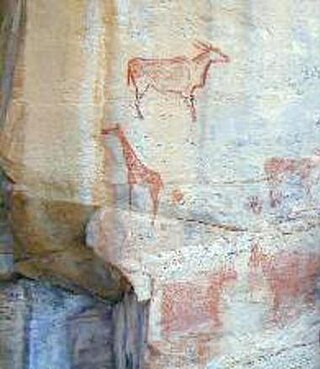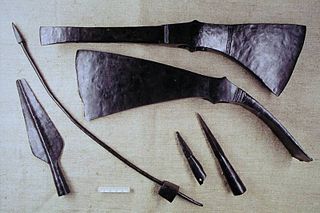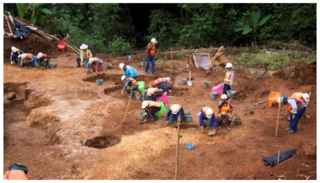The Chalcolithic was an archaeological period characterized by the increasing use of smelted copper. It followed the Neolithic and preceded the Bronze Age. It occurred at different periods in different areas, but was absent in some parts of the world, such as Russia, where there was no well-defined Copper Age between the Stone and Bronze ages. Stone tools were still predominantly used during this period.
The Iron Age is the final epoch of the three historical Metal Ages, after the Copper and Bronze Ages. It has also been considered as the final Age of the three-age division starting with prehistory and progressing to protohistory. In this usage, it is preceded by the Stone Age and Bronze Age. These concepts originated for describing Iron Age Europe and the Ancient Near East, but they now include other parts of the Old World.

A bloomery is a type of metallurgical furnace once used widely for smelting iron from its oxides. The bloomery was the earliest form of smelter capable of smelting iron. Bloomeries produce a porous mass of iron and slag called a bloom. The mix of slag and iron in the bloom, termed sponge iron, is usually consolidated and further forged into wrought iron. Blast furnaces, which produce pig iron, have largely superseded bloomeries.

The Timna Valley is located in southern Israel in the southwestern Arava/Arabah, approximately 30 kilometres (19 mi) north of the Gulf of Aqaba and the city of Eilat. The area is rich in copper ore and has been mined since the 5th millennium BCE. During early antiquity, the area would have been part of the Kingdom of Edom.

Igbo-Ukwu is a town in the Nigerian state of Anambra in the south-central part of the country. The town comprises three quarters namely Obiuno, Ngo, and Ihite with several villages within each quarter and thirty-six (36) administrative wards. It is also bordered by Ora-eri, Ichida, Azigbo, Ezinifite, Amichi, Isuofia, Ikenga and some other towns.

The Tsodilo Hills are a UNESCO World Heritage Site (WHS), consisting of rock art, rock shelters, depressions, and caves in southern Africa. It gained its WHS listing in 2001 because of its unique religious and spiritual significance to local peoples, as well as its unique record of human settlement over many millennia. UNESCO estimates there are over 4500 rock paintings at the site. The site consists of a few main hills known as the Child Hill, Female Hill, and Male Hill.
Mumba Cave, located near the highly alkaline Lake Eyasi in Karatu District, Arusha Region, Tanzania. The cave is a rich archaeological site noted for deposits spanning the transition between the Middle Stone Age and Late Stone Age in Eastern Africa. The transitional nature of the site has been attributed to the large presence of its large assemblage of ostrich eggshell beads and more importantly, the abundance of microlith technology. Because these type artifacts were found within the site it has led archaeologists to believe that the site could provide insight into the origins of modern human behavior. The cave was originally tested by Ludwig Kohl-Larsen and his wife Margit in their 1934 to 1936 expedition. They found abundant artifacts, rock art, and burials. However, only brief descriptions of these findings were ever published. That being said, work of the Kohl-Larsens has been seen as very accomplished due to their attention to detail, especially when one considers that neither was versed in proper archaeological techniques at the time of excavation. The site has since been reexamined in an effort to reanalyze and complement the work that has already been done, but the ramifications of improper excavations of the past are still being felt today, specifically in the unreliable collection of C-14 data and confusing stratigraphy.

Iron metallurgy in Africa developed within Africa; though initially assumed to be of external origin, this assumption has been rendered untenable; archaeological evidence has increasingly supported an indigenous origin. Some recent studies date the inception of iron metallurgy in Africa between 3000 BCE and 2500 BCE. Archaeometallurgical scientific knowledge and technological development originated in numerous centers of Africa; the centers of origin were located in West Africa, Central Africa, and East Africa; consequently, as these origin centers are located within inner Africa, these archaeometallurgical developments are thus native African technologies.

Archaeometallurgical slag is slag discovered and studied in the context of archaeology. Slag, the byproduct of iron-working processes such as smelting or smithing, is left at the iron-working site rather than being moved away with the product. As it weathers well, it is readily available for study. The size, shape, chemical composition and microstructure of slag are determined by features of the iron-working processes used at the time of its formation.
Lejja is a community comprising 33 villages in Enugu State of South-Eastern Nigeria. It is populated by the Igbo people and located about 14 Kilometers from Nsukka. It is the location of a prehistoric archaeological site which contains iron smelting furnaces and slag that dates back to 2000 BC. The village square at Otobo ugwu which is likely the first village square in Lejja that contains over 800 blocks of slag with an average weight, between 34 and 57 kg. Geophysical investigations have located buried iron slag in several other locations in the community.
Opi is a community in Enugu State of southeastern Nigeria. It is populated by the Igbo people and located in Nsukka region. It is the location of a prehistoric archaeological site which contains iron smelting furnaces and slag dated to 750 BC. Iron ore was smelted in natural draft furnaces and molten slag was drained through shallow conduits to collecting pits forming huge slag blocks weighing up to 47 kg. The operating temperatures are estimated to have varied between 1,155 and 1,450 °C.

The archaeology of Igbo-Ukwu is the study of an archaeological site located in a town of the same name: Igbo-Ukwu, an Igbo town in Anambra State in southeastern Nigeria. As a result of these findings, three excavation areas at Igbo-Ukwu were opened in 1959 and 1964 by Charles Thurstan Shaw: Igbo Richard, Igbo Isaiah, and Igbo Jonah. Excavations revealed more than 700 high quality artifacts of copper, bronze and iron, as well as about 165,000 glass, carnelian and stone beads, pottery, textiles and ivory beads, cups, and horns. The bronzes include numerous ritual vessels, pendants, crowns, breastplates, staff ornaments, swords, and fly-whisk handles.
Gogo Falls is an archaeological site near a former and since 1956 dammed waterfall, located in the Lake Victoria Basin in Migori County, western Kenya. This site is important to archaeology as it includes some of the earliest appearances of artifacts and domestic animals in the area. The findings at the site help to reconstruct the later prehistory around Lake Victoria, including a Pastoral Neolithic occupation by Elmenteitan peoples and a later Iron Age occupation. Artifacts found at the site included pottery and iron artifacts. Through these artifacts some of the cultural traditions of the people who lived near Gogo Falls were discovered.
Munsa is an archaeological site in Uganda, located in the south-eastern part of Bunyoro, and is commonly recognized by a rocky hill known by the locals as "Bikegete", which is enclosed within an earthworks system of ancient ditches. The site is approximately 5 kilometres (3.1 mi) north-west of Kakumiro township in Bugangaizi County, Kakumiro District. "Munsa" is a Runyoro(Lunyoro/Runyoro Edited by Nicholas Aliganyira Nkuuna) name that means "in the trenches". The architects of the earthworks are unknown, although it has been speculated that the site can be linked to the Bachwezi. There is no evidence for this, however, and it seems likely that association of Munsa with the Bachwezi or Chwezi is a recent development.
Point Rosee, previously known as Stormy Point, is a headland near Codroy at the southwest end of the island of Newfoundland, on the Atlantic coast of Canada.

People first began to be interested in Malawi's prehistoric past in the 1920s. Excavations of sites in nearby countries, Tanzania and Zambia, made archaeologists believe that they may find the same type of material culture in Malawi. In the 1920s, a series of lacustrine deposits was found at the northwest end of Lake Malawi. These beds contained fragmentary fossils and were mapped by Dr. F. Dixey. These findings sparked an interest to excavate more locations in Malawi.
Kemondo Iron Age Sites or KM2 and KM3 are Early Iron Age complex industrial archaeological sites in Kemondo ward, Bukoba Rural District, Kagera Region, Tanzania, excavated by a team led by archaeologist Peter Schmid in the late 1970s and 1980s. The excavations aimed at better understanding the iron smelting process and its ritual aspects in East Africa. At the KM2 and KM3 sites, Schmidt tested the hypothesis that the high combustion temperature of furnaces, discovered to be between 1,350–1,400 °C (2,460–2,550 °F), was caused by the preheating of air blasts. Preheating has been suggested to be a distinct feature of African Early Iron Age smelting techniques by ethnographic observations of the Haya people of northwestern Tanzania.
Church Rockshelter No.2 site situates near the Watauga River in Watauga County, North Carolina. It locates upstream from its twin site Church Rockshelter No.1 site. The No.2 site is east-southeast facing and includes two rock shelters formed by a Cranberry Gneiss outcrop. There is a lower shelter at the northern end and an upper shelter at the southern end. The site is owned by Charles Church, who discovered the site in the mid-1900s by finding many projectile points on the ground surface. A total of three excavations explored the site in the 1970s, 1975 and 2011 respectively. The site contains primarily stone and ceramic evidence from Early to Late Woodland period.

The Vilabouly Complex is an archaeological site that is located in the Savannakhet Province in Laos which holds copper smelting and copper mining during the Iron Age. The Vilabouly Complex is significant since it puts archaeologists in a predicament of when did the origin of bronze metallurgy begin in Southeast Asia. It was estimated that the site was around 400BC - AD 500 as well as 1000 - 400BC reaching both the Iron Age and Bronze Age of Southeast Asia.
Nsukka is a region located in Enugu State of Southeastern Nigeria that has drawn particular archaeological interest. This area has yielded several examples of iron, metal, clay, and stone production that have contributed to the country’s development over the years. In the territory referred to as Igboland, in which Nsukka resides, Alumona is recognized as a focal point for metal working, whilst Opi, Obimo, Lejja, Orba, Nrobo, Onyohor, Ekwegbe, and Umundu are related back to iron smelting.









